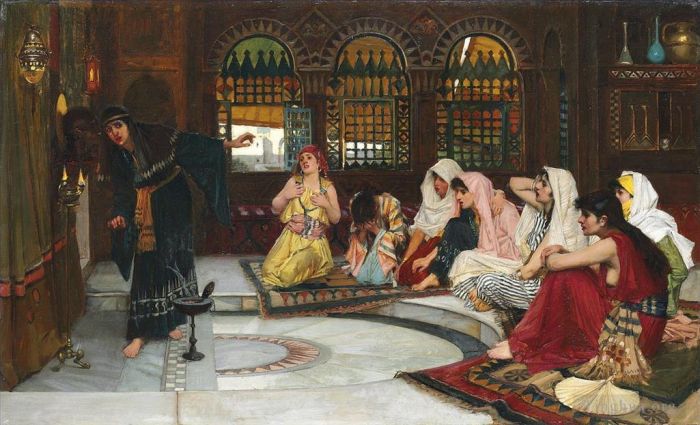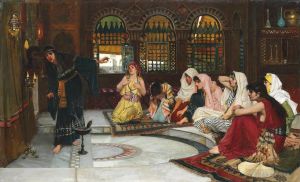Consulting the Oracle
John William Waterhouse
- Price: Price on Request
- Art Type: Oil Painting
- Size:
- English Comments: 0
- International Comments: 0
- Creating Date:
- Introduction and Works of John William Waterhouse >>
Keywords:
Consulting, Oracle
Work Overview
- Consulting the Oracle
Artist John William Waterhouse
Year 1884
Medium Oil on canvas
Dimensions 119 cm × 198 cm (47 in × 78 in)
Location Tate Gallery, London
Consulting the Oracle is an oil on canvas painting by John William Waterhouse. Waterhouse painted it in 1884; according to Anthony Hobson, "The Illustrated London News described it as one of the principal works of the year". Hobson describes the work as having a "keyhole composition" because a partial ring of women focus upon a single other (the priestess).[2]
Hobson goes on to say that the painting helps "to establish Waterhouse as a classical painter" because of his use of "classical, geometrical structures...the vertical, the horizontal and the circle". When he adds the diagonal, as "in the inclined figure of the priestess" and the out-of-place rug, it is a deliberately added tension.
Miracles, magic and the power of prophecy are common themes in Waterhouse's art. In this picture he shows a group of seven young girls, sitting in a semicircle round a lamplit shrine, waiting in excitement while the priestess interprets the words of the Oracle.
The picture was exhibited at the Royal Academy with the following explanation in the catalogue: 'The Oracle or Teraph was a human head, cured with spices, which was fixed against the wall, and lamps being lit before it and other rites performed, the imagination of diviners was so excited that they supposed that they heard a low voice speaking future events.' The setting is probably imaginary, but has an exotic, middle-eastern flavour, derived from the work of artists such as J.F. Lewis (1805-1876), rather than from personal experience. The atmosphere is heady with incense and the priestess gestures to the women to be silent as she strains to interpret the utterings of the mummified head.
Hobson compares the painting's composition to the shape of a keyhole. As he explains, 'This refers not to some telescopic view of the scene but to the keyhole shape of the figure grouping, in which a ring of spectators concentrate their attention upon another single figure' (quoted in Hobson 1989, pp.31-4). The composition, for all its exoticism, is essentially classical. The series of arched windows, the semi-circular design of the floor and the sweep of the marble step set up a rhythm within the painting. This is counterbalanced by the diagonals of the patterned rugs and the leaning body of the priestess, her hand silhouetted against the daylight, streaming through the open window. The women's varied expressions of apprehension add to the atmosphere of tension as the priestess waits for the oracle to speak.
Contemporary critics remarked on the 'hysteric awe' of the semicircle of women seeking the prophecies of the Teraph and the 'terror' of the priestess as she 'interprets its decrees' (quoted in Hobson 1989, p.34). The Illustrated London News featured the picture as one of the principal works of the year and reproduced it across two pages of an extra supplement. It was bought by Sir Henry Tate, who included it in his founding bequest to the nation in 1894.
A study for the composition, in grey and brown wash, is also in the Tate collection (Tate T02106).
- Copyright Statement:
All the reproduction of any forms about this work unauthorized by Singing Palette including images, texts and so on will be deemed to be violating the Copyright Laws.
To cite this webpage, please link back here.
- >> English Comments
- >> Chinese Comments
- >> French Comments
- >> German Comments
- >>Report
- The lady of shalott study JW
- Apollo and daphne FR
- The SirenA Arthurian
- Penelope and the Suitors
- The Awakening of Adonis
- Mariana in the South
- Sweet summer
- 5 Ophelia
- Pandora
- The Magic Circle
- Crystal Ball
- Ulysses and the Sirens
- Flora
- Sleep and his half brother death JW
- Miranda The Tempest
- The Flower Picker JW
- The Lady of Shalott
- At Capri
- Flora and the zephyrs
- Portrait of Phyllis Waterlo
- Flora JW
- Destiny
- Narcissus JW
- The annunciation
- Thisbe
- Lamia
- Psyche Entering Cupids Garden
- Circe offering the Cup to Ulysses
- A Naiad or Hylas with a Nymph John William Waterhous
- In the Peristyle
- Saint Cecilia
- Two Little Italian Girls by a Village
- The household gods JW
- La belle dam sans mercie
- Maidens picking study
- Gather ye rosebuds study JW
- Boreas
- My Sweet Rose
- Juliet JW
- After the dance JW
- Diogenes
- Circe Invidiosa
- The Danaides
- Portrait of Mrs Charles Schreiber
- The Lady of Shalott
- The Favourites of the Emperor Honorius
- Gathering almond blossoms JW
- Echo and Narcissus
- Ophelia
- Fair Rosamund
- Gathering summer flowers in a devonshire garden JW
- Gather ye rosebuds
- The Sorceress
- Miss Margaret Henderson
- Tristan and Isolde Sharing the Potion
- Miss Betty Pollock
- Listening to His Sweet Pipings
- Dante and Beatrice
- Windswept
- Dolce Far Niente
- Nymphs finding the head of orpheus study JW
- Study For The Lady Of Shallot
- 5
- A Sick Child Brought into the Temple of Aesculapius
- Knight
- Women with water jugs
- The lady clare JW
- The Necklace
- Vanity
- Mariamne
- Consulting the Oracle
- Hylas and the Nymphs
- A Mermaid
- At the Shrine
- The Orange Gatherers
- The enchanted garden
- The remorse of nero after the murdering of his mother JW
- Saint Eulalia
- Psyche Opening the Golden Box
- Ariadne
- Cleopatra JW
- Jason and medea FR
- Gather ye rosebuds while ye may 1909
- Study For Gather Ye Rosebuds While Ye May
- Hylas and the nymphs study JW
- StudyfortheLadyClareSmall









 Singing Palette
Singing Palette